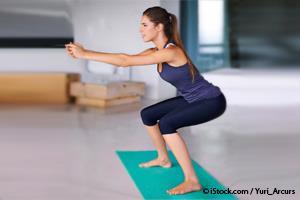Top 5 Exercises for Tighter Buttocks

Buttock augmentation is one of the fastest growing areas of plastic surgery. Such procedures surged 86 percent from 2013 to 2015.1 But whether you’re looking for a rounder, firmer or curvier behind, you can achieve many of these coveted effects with exercise.
American Council on Exercise (ACE) personal trainer Keli Roberts told ACE Fitness Matters:2
“They don’t want it to look flat or saggy back there … People are looking for that nice curvaceous shape to their glutes — and to have that you need muscle.”
Fortunately, many of the best butt exercises can be done right from the comfort of your own home — no gym or bulky equipment required.
5-Exercise Circuit for a Tighter Backside
Manhattan-based personal trainer Lindsay Laidlaw, CPT, compiled the following backside circuit for the Epoch Times.3 Complete all repetitions of exercise one, then move on to the next, continuing through all five.
Upon completion, rest for one minute then start the circuit again. All five exercises should have 30 repetitions each, and the entire circuit should be repeated five times in a row (with one-minute rest periods in between each five-exercise set).
1. Squats (30 reps)
Squats actually promote body-wide muscle building by catalyzing an anabolic environment, which primes your muscles for growth.
In the video above, personal trainer and coach Darin Steen demonstrates safe squat techniques for beginner, intermediate, and advanced. A basic squat is performed as follows:
- Warm up
- Stand with your feet just over shoulder width apart
- Keep your back in a neutral position, and keep your knees centered over your feet
- Slowly bend your knees, hips, and ankles, lowering until you reach a 90-degree angle
- Return to starting position — repeat 15 to 20 times, for 2 to 3 sets for beginners (do this two or three times a week)
- Breathe in as you lower, breathe out as you return to starting position
2. Bulgarian Split-Squat (15 reps on each leg)
Grab a chair or position yourself in front of a couch that reaches a height between mid-calf and knee level.
- “Place your left foot on top of the elevated surface and hop the right foot forward about two feet, far enough forward so that at the bottom of the movement, the front knee will be bent at 90-degrees and will not cross your toes.
- Once you are set up and feel stable, lower your body by bending both knees to the point where your front thighbone is parallel to the floor.”
3. Cook Hip Lift (15 reps on each side)
Named after physical therapist Gray Cook, this exercise works your glutes while also targeting tight hip flexors, which may cause low back pain.
- “Start by lying face-up on the floor or a mat. Bend both knees so the feet are on the ground about 12 inches from your hips.
- Draw your left knee toward your chest and clasp both hands around the elevated leg just under the kneecap, on top of the shin.
- Next, keeping tension through the arms and back, drive down through the right heel still on the floor, sending the hips up toward the ceiling.
- Pause briefly at the height of the movement before lowering back down with control.
- You should expect to feel fatigue, not only in the glutes, but also in your back, arms, and abs.”
4. Reverse Hyperextension (30 reps)
This exercise works the upper muscles of your buttocks, which according to Laidlaw, “will get the back pockets of your jeans to fit just a little higher and tighter.”
- “Lie with your pelvis on top of a ball or face down on the floor or a mat.
- Keeping both legs straight and spine neutral, use the glute muscles to lift both legs smoothly off of the floor toward the ceiling.
- Gently lower them back down to the floor.”
5. Froggers (30 repetitions)
This exercise is performed on the floor or on a mat; it works both your glutes and your hamstrings.
- “Lie face down and bend both legs at 90 degrees.
- Keep the knees separated at about hip distance and press the heels together. This will activate more muscle fibers of the hip complex, especially the inner thighs.
- Keeping pressure between the heels as well as a neutral spine, press the soles of the feet flat toward the ceiling.
- Pause briefly squeezing the glutes before lowering back down to starting position.”
A 15-Minute Power Workout for Your Backside
Squats have long been regarded as the best exercise to develop your backside, and indeed they are one of the best. But they’re not the only one. For people with certain back or joint problems, squats may be difficult to achieve, so having a variety of exercises to target your glutes makes sense.
Plus, it’s far more interesting than doing only squats. In a study commissioned by ACE and led by John Porcari, Ph.D. and Blake Ristvedt, M.A, from University of Wisconsin, La Crosse, several exercises were found to work just as well as squats to train your buttocks.4 This includes:
- Lunges
- Step-ups
- Quadruped hip extensions
- Four-way hip extensions
Ristvedt told ACE Fitness Matters:5
“You don’t just have to do only squats-squats-squats …
Sure, traditional squats are obviously a great exercise for the glutes, but some people are limited [because of] different joint problems or other reasons, and you can just substitute these other exercises and still get an equally great workout for your glutes.”
A 15-minute workout that includes some of these butt boosters follows. It was designed by ACE Master Trainer Keli Roberts, who noted that it offers far more than just a firmer backside:6
“It’s really important to have strong glutes, but it’s not just from a vanity point of view … If you have a strong butt you’re also going to have a strong back. Butts and backs go together, so you’ll have good carryover into your back muscles. And that’s a really useable functional strength.”
To perform this workout, you’ll need a pair of dumbbells and access to a low bench or wall. Do one set of each exercise (you can repeat the entire circuit two or more times if you want). Warm up with a set of 15 squats and then continue as follows:7
Front Lunges
“Hold a dumbbell in each hand, standing tall with good posture. Step forward with the right foot, keeping the head up and spine neutral. Drop your left knee toward the floor by bending both knees, making sure to keep the front heel down and the knee directly over the center of the foot. Push down and forward through your heel to return to the starting position. Repeat on the other side, alternating for eight to 12 reps per side.”
Quadruped and Step-Up (Super Set)
“Start with the quadruped: On your hands and knees, slightly contract your abdominals to stabilize your torso and spine. Lift one leg up, keeping the knee bent at 90 degrees. Lift the leg until the bottom of the foot is pointing toward the ceiling and the leg is lined up with the body. Repeat on the same side for eight to 12 reps. If you are outside, you can do this exercise kneeling on a park bench, then use the bench for the step-up.
Next, the step-up: Stand with good posture behind a tall step or box [approximately 15 inches high] while holding a dumbbell in each hand. Place your left foot on top and transfer your weight to that leg.
Push down with your left foot (especially the heel), straightening your leg, to come up on top of the box. Use the left leg only; keep the right leg passive, especially as you initiate the step-up. Repeat for eight to 12 reps on the same side, then change legs and start with the quadruped exercise on the other side.”
Single-Leg Squat
“Stand on a box or bench with your weight on your left leg and your right leg hanging off the side. Bend the weightbearing knee and lower while pushing the hips back. Push down through the heel to come up. Repeat for eight to 12 reps and change sides. If you are exercising outside, you can use a park bench or a low wall.”
Reap the Many Rewards of Bodyweight Exercise
The buttocks exercises described above are examples of bodyweight exercises, which are great because you can do them anywhere, anytime, at your own pace and level, alone or with a friend. They don’t cost a penny, because your own body provides all the resistance needed to challenge your muscles.
There’s no equipment necessary and no gym needed, yet by doing a variety of bodyweight exercises, it’s possible to train every muscle in your body while also getting cardiovascular benefits. One of the best parts about bodyweight exercises is their versatility. There’s an appropriate exercise for beginners and experts alike, and often the same exercise is suitable for varying levels of difficulty with minor tweaks in technique.
In the video above, Jill Rodriguez, one of the personal trainers at Mercola.com, demonstrates basic bodyweight exercises and how to add levels of difficulty, as you’re able.
The exercises above focus on your lower body, but you can use bodyweight exercises for a full-body workout too. Bodyweight exercises will help build your strength and cardiovascular health while improving your balance, core muscles and flexibility. Plus, aside from the improvements to your physical state, bodyweight exercise provides some other goodies as well:
- Fat is burned quickly.If you want to shed a few pounds, bodyweight training can help simply by including some Burpees. The metabolic increase they trigger will help you melt away the pounds.8
- It’s convenient. So often, the reason people do not exercise is simply that it’s inconvenient. You have to go to a gym, or go outside when it’s raining, or stay inside when it’s beautiful outdoors. With bodyweight exercise you do not need to pull equipment out and get set up. You do not need to fit exercise into a particular schedule. You just do it when it’s convenient and fits your schedule.
- It’s cheap. There is no equipment required. Your own body is all the equipment you’ll need.
- It’s fun! There’s no boredom because you can vary your workout. There are hundreds, if not thousands, of variations that you can try.
- It’s satisfying. You’ll see and feel results quickly. Your mind will be sharper. You’ll feel better. If you’re overweight, you’ll probably start losing weight quickly. You’ll look better and your energy levels will increase.








